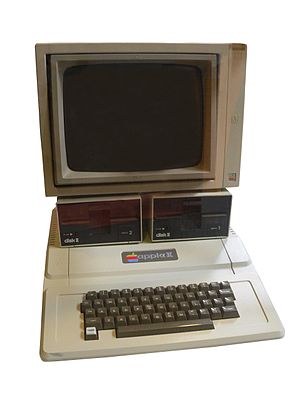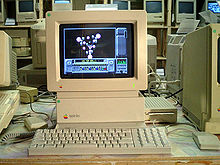The Apple II (often rendered Apple ][ or Apple //)  was one of the first highly successful mass produced microcomputer products, designed primarily by Steve Wozniak, manufactured by Apple Computer (now Apple Inc.)
was one of the first highly successful mass produced microcomputer products, designed primarily by Steve Wozniak, manufactured by Apple Computer (now Apple Inc.)
During 1980 Apple went public. Within a year, the stocks' value increases by 1700%!
Throughout the years, a number of different models were introduced and sold. By the end of its production in 1993, somewhere between five and six million Apple II series computers had been produced.
The Apple II became one of the most recognizable and successful computers during the 1980s and early 1990s. It was aggressively marketed through volume discounts and manufacturing arrangements to educational institutions which resulted in it being the first computer in widespread use in American secondary schools. The computer was especially popular with business users and families.
At the height of its evolution, towards the late 1980s, the platform had the graphical look of a hybrid of the Apple II and Macintosh with the introduction of the Apple IIGS.
Despite the introduction of the Motorola 68000-based Apple Lisa system in 1983, and its more successful cousin the Macintosh in 1984, the relatively unsophisticated Apple II series was Apple's primary revenue source for most of the following decade: with its associated community of third-party developers and retailers it was once a billion-dollar-a-year industry.
The Apple II was designed to look more like a home appliance than a piece of electronic equipment. The lid popped off the beige plastic case without the use of tools, allowing access to the computer's internals, including the motherboard with eight expansion slots, and an array of random access memory (RAM) sockets which could hold up to 48 kilobytes worth of memory chips.
Apple released the Apple IIc in April 1984, billing it as a portable Apple II, because it could be easily carried, though unlike modern portables it lacked a built-in display and battery. The IIc even sported a carrying handle that folded down to prop the machine up into a typing position. It was the first of three Apple II models to be made in the Snow White design language, and the only one that used its unique creamy off-white color.
The next member of the line was the Apple IIGS computer, released in September 15, 1986. A radical departure from the existing Apple II line, the IIGS featured a true 16-bit microprocessor, the 65C816, operating at 2.8 MHz with 24-bit addressing, allowing expansion up to 8 MB of RAM without the bank-switching hassles of the earlier machines (RAM cards with more than 4 MB were never directly supported by Apple). It introduced two completely new graphic modes sporting higher resolutions and a palette of 4,096 colors; however, only 4 (at 640×200 resolution) or 16 (at 320×200 resolution) colors could be used on a single line at a time, although a technique known as dithering was often employed in software to increase the number of perceived colors.
The Apple II series of computers had an enormous impact on the technology industry and on everyday life. The Apple II was the first personal computer many people ever saw, and its price was within the reach of many middle-class families. Its popularity bootstrapped the entire computer game and educational software markets and began the boom in the word processor and computer printer markets
http://en.wikipedia.org/wiki/Apple_II_series




No comments:
Post a Comment